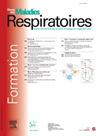Using dual energy CT Scans to analyse blood perfusion compensation following resection of cancerous lobes
IF 0.5
4区 医学
Q4 RESPIRATORY SYSTEM
引用次数: 0
Abstract
Introduction
Comparison of pulmonary perfusion before and after lung resection may provide a better understanding of compensation phenomena and, more importantly, additional clinical information for the inclusion of patients in these surgeries. To evaluate the pulmonary perfusion mechanisms in patients with lung diseases (COPD, nodule…), we used a novel approach using Dual energy CT scan (DECT). The aim is to produce a perfusion profile in surviving lobes, before and after surgery, allowing to quantize and localize potential changes in blood perfusion.
Methods
The CLIPPCAIR prospective study enrolls patients undergoing pulmonary resection due to non-small cell lung cancer, with the majority having pulmonary comorbidities such as COPD. 30 patients from this study were examinated. CLIPPCAIR focuses on patients scheduled for resection, excluding those with COPD stages 3 or 4. Patients performed a FEV1 (Forced Expiratory Volume in 1 second), and a FVC (Forced Vital Capacity) to assess their respiratory performances. The recording of these measurements provides elements to determine the COPD GOLD. For each patient, a DECT with an iodine injection (350 mg/mL, Iomeron, Bracco Imaging) is achieved and reconstructed by GE Revolution (KvP switch between 80 and 140.200 mA). Iodine concentration and lung parenchyma density maps were then generated. Iodine concentration is used as a biomarker for blood concentration. Lung blood vessels are segmented using Machine Learning. Then, the blood concentration is measured in voxels located in alveolar and small vessel areas, i.e. non large vessels areas. The “large” vessels are those segmented by the ML algorithm, meaning a diameter larger than the voxel resolution, giving a cross-sectional area of 2.6 mm2. This perfusion metric is plotted against the distance to the nearest blood vessel of cross-sectional area greater than 5 mm2 (BV5) (figure 1). This is done before and after surgery in all remaining lobes. It is then possible to compare the perfusion profile of the lobes before and after the resection.
Results
Patients from the CLIPPCAIR cohort lost on average 21 % (standard deviation: 5.2) of their volume, while only showing a slight decrease of their DLCO and FEV1 performances, respectively 7.2 (6.7)% and 5.9 (5.5)%. While these metrics are not a complete picture of respiratory performances, their moderate decrease highlights the existence of compensation mechanisms in the remaining lobes. Indeed, we observe a statistically significant increase of 5.1 (1.6)% in iodine concentration -a proxy for blood perfusion- in the remaining lobes post surgery (p-value < 0.05).
Conclusion
Patients undergoing lung resection show much better DLCO and FEV1 than expected. We show that there is an increase in blood perfusion in the remaining lung parenchyma, which could explain this favorable outcome for the patients regardless of the spirometric profile of the patients.
双能CT扫描分析癌叶切除后的血流灌注代偿
肺切除术前后肺灌注的比较可以更好地理解代偿现象,更重要的是,为纳入这些手术的患者提供额外的临床信息。为了评估肺部疾病(COPD、结节等)患者的肺灌注机制,我们采用了一种新的方法——双能CT扫描(DECT)。目的是在手术前和手术后,在存活的肺叶中产生灌注剖面,从而量化和定位血液灌注的潜在变化。CLIPPCAIR前瞻性研究纳入了因非小细胞肺癌而行肺切除术的患者,其中大多数患有肺部合并症,如COPD。本研究对30例患者进行了检查。CLIPPCAIR专注于计划切除的患者,不包括COPD 3期或4期患者。患者通过FEV1(1秒用力呼气量)和FVC(用力肺活量)来评估他们的呼吸功能。这些测量的记录提供了确定COPD GOLD的元素。对每位患者进行碘注射(350 mg/mL, Iomeron, Bracco Imaging)的DECT,并通过GE Revolution (KvP在80和140.200 mA之间切换)重建。然后生成碘浓度和肺实质密度图。碘浓度被用作血药浓度的生物标志物。使用机器学习对肺血管进行分割。然后,测量位于肺泡和小血管区域(即非大血管区域)的血浓度体素。“大”血管是指通过ML算法分割的血管,即直径大于体素分辨率的血管,其横截面积为2.6 mm2。该血流灌注指标与横截面积大于5 mm2的最近血管的距离(BV5)相对应(图1)。这是在所有剩余肺叶手术前后完成的。这样就可以比较切除前后脑叶的灌注情况。结果CLIPPCAIR队列患者的体积平均下降21%(标准差:5.2),DLCO和FEV1的表现仅略有下降,分别为7.2(6.7)%和5.9(5.5)%。虽然这些指标并不是呼吸性能的全貌,但它们的适度下降突出了其余叶中补偿机制的存在。事实上,我们观察到手术后剩余叶中碘浓度(血液灌注的代表)显著增加了5.1% (1.6)% (p值<;0.05)。结论肺切除术患者的DLCO和FEV1明显优于预期。我们发现,在剩余的肺实质中,血液灌注增加,这可以解释无论患者的肺活量谱如何,患者都能获得这种有利的结果。
本文章由计算机程序翻译,如有差异,请以英文原文为准。
求助全文
约1分钟内获得全文
求助全文
来源期刊

Revue des maladies respiratoires
医学-呼吸系统
CiteScore
1.10
自引率
16.70%
发文量
168
审稿时长
4-8 weeks
期刊介绍:
La Revue des Maladies Respiratoires est l''organe officiel d''expression scientifique de la Société de Pneumologie de Langue Française (SPLF). Il s''agit d''un média professionnel francophone, à vocation internationale et accessible ici.
La Revue des Maladies Respiratoires est un outil de formation professionnelle post-universitaire pour l''ensemble de la communauté pneumologique francophone. Elle publie sur son site différentes variétés d''articles scientifiques concernant la Pneumologie :
- Editoriaux,
- Articles originaux,
- Revues générales,
- Articles de synthèses,
- Recommandations d''experts et textes de consensus,
- Séries thématiques,
- Cas cliniques,
- Articles « images et diagnostics »,
- Fiches techniques,
- Lettres à la rédaction.
 求助内容:
求助内容: 应助结果提醒方式:
应助结果提醒方式:


